GE PG, GG, HG, GG50T06TVG, SG User Manual
...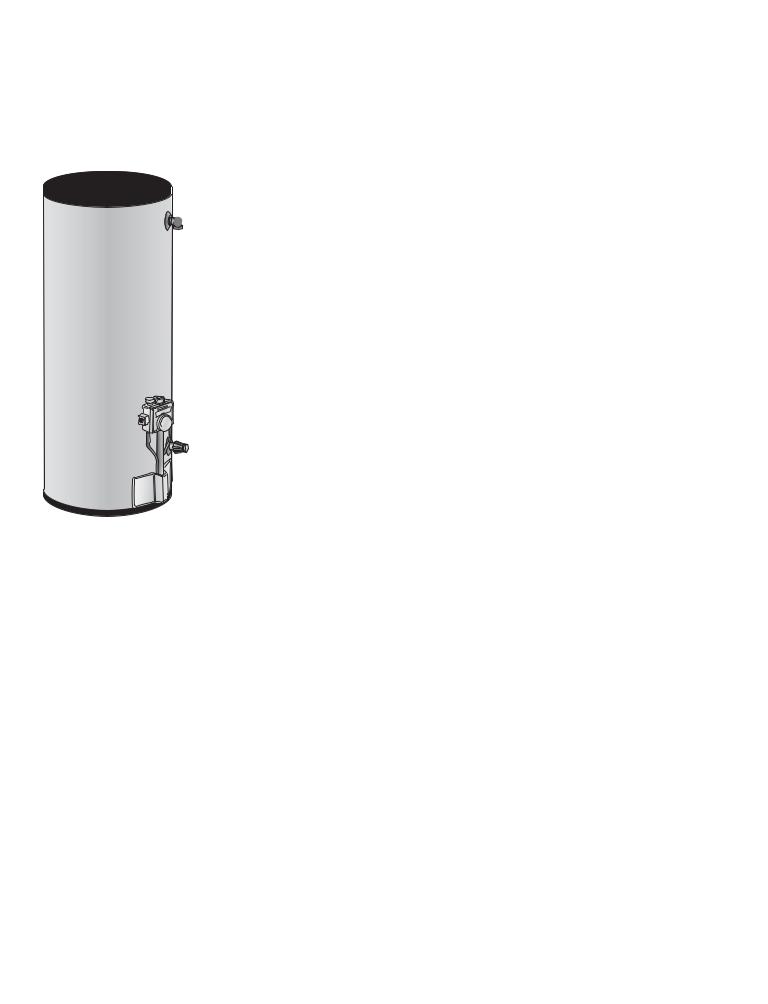
!WARNING: This water heater is not suitable for use in manufactured (mobile) homes!
& Care Manual
Installation Instructions for the Installer
 Water Heaters
Water Heaters
Residential 30, 40 and 50 Gallon
Model: HG Series, GG Series, GP Series, PG Series, SG Series,
SG Series with SmartWater™ Ignition System
The purpose of this manual is twofold: one, to provide the installer with basic directions and recommendations for the proper installation and adjustment of the water heater; and two, for the owner–operator, to explain the features, operation, safety precautions, maintenance and troubleshooting of the water heater. This manual includes a parts list.
It is imperative that all persons who are expected to install, operate or adjust this water heater read the instructions carefully so that they may understand how to perform these operations. If you do not understand these instructions or any terms within it, seek professional advice.
Any questions regarding the operation, maintenance, service or warranty of this water heater should be directed to the seller from whom it was purchased. If additional information is required, refer to the section “If You Need Service….”
Do not destroy this manual. Please read carefully and keep in a safe place for future reference.
!Recognize this symbol as an indication of Important Safety Information!
!California Proposition 65 Warning: This product contains chemicals known to the State of California to cause cancer, birth defects or other reproductive harm.
!WARNING: If the information in these instructions is not followed exactly, a fire or explosion may result causing property damage, personal injury or death.
! FOR YOUR SAFETY!
—Do not store or use gasoline or other flammable vapors or liquids or other combustible materials in the vicinity of this or any other appliance.
To do so may result in an explosion or fire.
—WHAT TO DO IF YOU SMELL GAS
●Do not try to light any appliance.
●Do not touch any electrical switch; do not use any phone in your building.
●Immediately call your gas supplier from a neighbor’s phone. Follow the gas supplier’s instructions.
●If you cannot reach your gas supplier, call the fire department.
●Do not return to your home until authorized by the gas supplier or fire department.
—Improper installation, adjustment, alteration, service or maintenance can cause property damage, personal injury or death. Refer to this manual. Installation and service must be performed by a qualified installer, service agency or the gas supplier.
ESIG |
|
D |
N |
C |
D |
® |
|
ERTIFIE |
Manufactured under trademark license by:
Rheem Manufacturing Company
2600 Gunter Park Drive East, Montgomery, AL 36109-1413
Part No. AP13204-4 (01/05) Pub. No. 49-50103 JR
Printed in USA
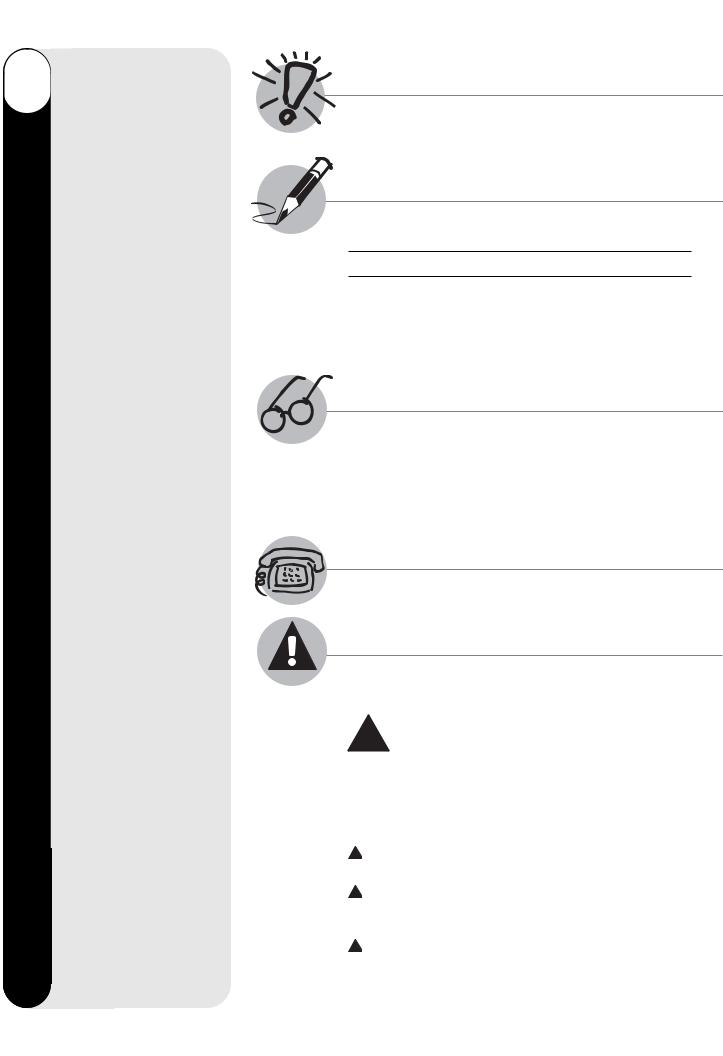
Customer Service Troubleshooting Tips Care and Cleaning Operating Instructions Installation Instructions Safety Instructions
LP Gas Models . . . . . . . . . . . . . 5
Installation Instructions
Location. . . . . . . . . . . . . . . . . . . . 7
Water Supply Connections. . . 9
Gas Supply. . . . . . . . . . . . . . . . . 11
Pipe Insulation . . . . . . . . . . . . . 13
Heat Traps . . . . . . . . . . . . . . . . 13
Installation Checklist . . . . . . . 14
Potable/Space Heating . . . . . 15
Operating Instructions
Lighting Instructions . . . . . . . 16
Water Temperature. . . . . . 17, 18
Care and Cleaning
Draining . . . . . . . . . . . . . . . . . . . 19
Maintenance. . . . . . . . . . . . . . . 19
Burner Inspection. . . . . . . . . . 20
Extended Shut-Down . . . . . . 20
Troubleshooting Tips
Before You Call
For Service . . . . . . . . . . . . . 21, 22
Customer Service
Parts List . . . . . . . . . . . . . . . . . 25 If you need service . . . . . . . . . 26 Product Registration. . . 27, 28
2
Registration Card that is
in the back of this manual.
FOR YOUR RECORDS
Write the model and serial numbers here:
#
#
You can find them on a label on the appliance.
Staple sales slip or cancelled check here.
Proof of the original purchase date is needed to obtain service under the warranty.
READ THIS MANUAL
Inside you will find many helpful hints on how to use and maintain your water heater properly. Just a little preventive care on your part can save you time and money over the life of your water heater.
You’ll find many answers to common problems in the Before You Call For Service section. If you review our chart of Troubleshooting Tips first, you may not need to call for service at all.
IF YOU NEED SERVICE
If you do need service, you can relax knowing help is only a phone call away. For service call 800-431-1549.
READ THE SAFETY INFORMATION
Your safety and the safety of others are very important. There are many important safety messages in this manual and on your appliance. Always read and obey all safety messages.
!as an indication of Important Safety Information! This symbol alerts you to potential hazards that can kill or hurt you and others.This is the safety alert symbol. Recognize this symbol
All safety messages will follow the safety alert symbol and either the word “DANGER”, “WARNING”, “CAUTION” or “NOTICE”.
These words mean:
! DANGER An imminently hazardous situation that will result in death or serious injury.
! WARNING A potentially hazardous situation that could result in death or serious injury and/or damage to property.
! CAUTION A potentially hazardous situation that may result in minor or moderate injury.
Notice: Attention is called to observe a specified procedure or maintain a specific condition.

IMPORTANT SAFETY INFORMATION. READ ALL INSTRUCTIONS BEFORE USING.
Be sure to read and understand the entire Use and Care Manual before attempting to install or operate this water heater. It may save you time and money. Pay particular attention to the Safety Instructions. Failure to follow these warnings could result in serious bodily injury or death. Should you have problems understanding the instructions in this manual, or have any questions, STOP, and get help from a qualified service technician, or the local gas utility.
! DANGER!
INSTALL THE DRAFT HOOD AND PROPERLY VENT THE WATER HEATER…
Failure to install the draft hood and properly vent the water heater to the outdoors as outlined in the Venting Section of the Installation Instructions in this manual can result in unsafe operation of the water heater. To avoid the risk of fire, explosion, or asphyxiation from carbon monoxide, never operate this water heater unless it is properly vented and has an adequate air supply for proper operation. Be sure to inspect the vent system for proper installation at initial start-up; and at least annually thereafter. Refer to the Care and Cleaning section of this manual for more information regarding vent system inspection.
! WARNING!
Gasoline, as well as other flammable materials and liquids (adhesives, solvents, paint thinners, etc.), and the vapors they produce are extremely dangerous. DO NOT handle, use or store gasoline or other flammable or combustible materials anywhere near or in the vicinity of a water heater or any other appliance. Be sure to read and follow the warning label pictured below and other labels on the water heater, as well as the warnings printed in this manual. Failure to do so can result in property damage, bodily injury or death.
! W A R N I N G
FLAMMABLES |
Flammable Vapors |
FIRE AND EXPLOSION HAZARD
Can result in serious injury or death.
! Do not store or use gasoline or other flammable vapors and liquids in the vicinity of this or any other appliance. Storage of or use of gasoline or other flammable vapors or liquids in the vicinity of this or any other appliance can result in serious injury or death.
Service Customer Tips Troubleshooting Cleaning and Care Instructions Operating Instructions Installation Instructions Safety
3
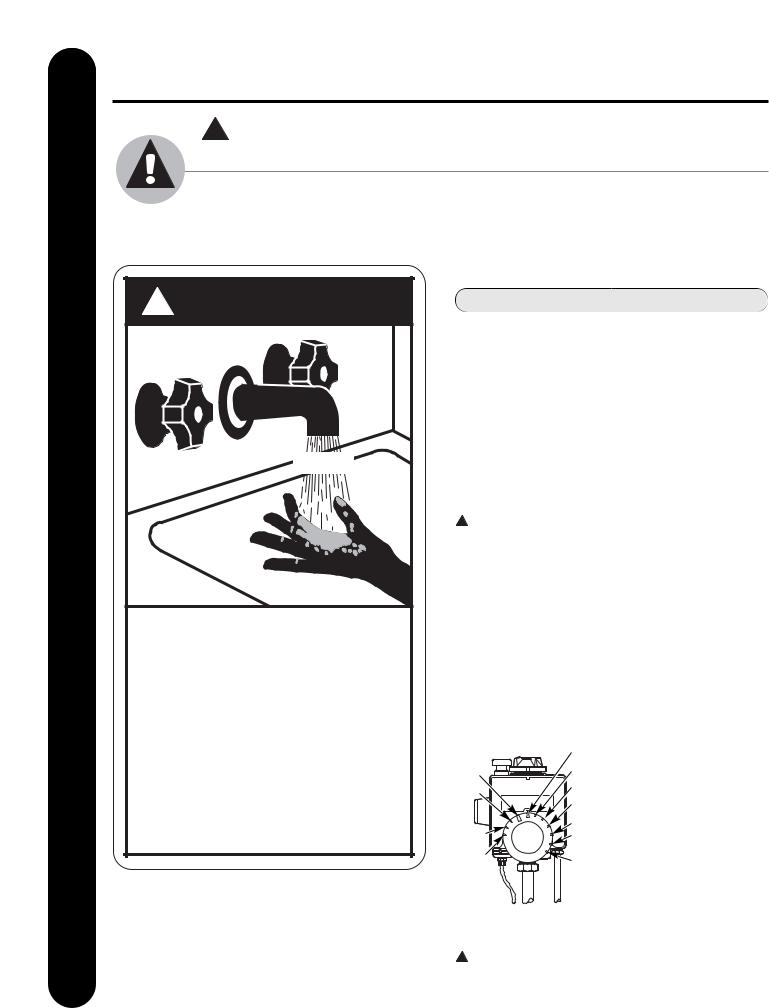
Customer Service Troubleshooting Tips Care and Cleaning Operating Instructions Installation Instructions Safety Instructions
IMPORTANT SAFETY INFORMATION. READ ALL INSTRUCTIONS BEFORE USING.
! DANGER!
WATER TEMPERATURE SETTING
Safety and energy conservation are factors to be considered when selecting the water temperature setting of a water heater’s thermostat. Water temperatures above 125°F can cause severe burns or death from scalding. Be sure to read and follow the warnings outlined on the label pictured below. This label is also located on the water heater.
! D A N G E R
HOT
BURN
Water temperature over 125°F can cause severe burns instantly or death from scalds.
Children, disabled and elderly are at highest risk of being scalded.
See instruction manual before setting temperature at water heater.
Feel water before bathing or showering.
Temperature limiting valves are available, see manual.
Notice: Mixing valves are available for reducing point of use water temperature by mixing hot and cold water in branch water lines. Contact a licensed plumber or the local plumbing authority for further information.
Time/Temperature Relationship in Scalds
Water Temperature |
Time To Produce a Serious Burn |
120°F |
More than 5 minutes |
125°F |
11/2 to 2 minutes |
130°F |
About 30 seconds |
135°F |
About 10 seconds |
140°F |
Less than 5 seconds |
145°F |
Less than 3 seconds |
150°F |
About 11/2 seconds |
155°F |
About 1 second |
Table courtesy of Shriners Burn Institute
The chart shown above may be used as a guide in determining the proper water temperature for your home.
! DANGER: Households with small children, disabled, or elderly persons may require a 120°F or lower gas control (thermostat) setting to prevent contact with “HOT” water.
Maximum water temperatures occur just after the burner has shut off. To find water temperature being delivered, turn on a hot water faucet and place a thermometer in the water stream and read the thermometer. (See pages 17 and 18 for more details.)
The temperature of the water in the heater can be regulated by setting the temperature dial on the front of the thermostat. To comply with
safety regulations the gas control (thermostat)
|
|
was set |
|
|
120°F |
at its lowest setting |
|
130°F |
110°F |
before the water heater |
|
140°F |
100°F |
was shipped from the |
|
factory. |
|||
W A |
90°F |
||
|
|
|
|
|
|
|
TION |
|
R |
|
||
150°F |
|
|
|
|
|
|
M |
|
||
|
|
|
U |
|
|
|
|
|
||
T |
C |
A |
|
|
|
|
|
|
||
|
|
|
|
|
|
|
V |
|||
O |
|
|
|
|
|
|
S |
Y |
||
|
|
|
|
|
|
E |
R |
A |
||
|
H |
|
|
|
|
|
|
S |
U |
|
|
|
|
|
W |
H OTTE |
E |
A |
I NJ |
C |
|
|
|
T |
|
A |
CR |
|
LD |
|
A |
|
|
|
|
|
TE R IN |
|
IT |
||||
160°F |
|
|
HE |
|
|
CA |
|
|||
|
|
|
|
RISK OFS |
|
|
|
|||
|
|
|
|
|
|
|
|
O |
|
|
|
|
|
|
|
|
N |
|
|||
|
|
|
|
|
|
|
|
|
|
|
Temperatures are approximate
80°F
70°F
60°F
The illustration at the left details the approximate water temperature for each mark on the Gas Control (Thermostat) Temperature Dial.
! DANGER: Hotter water increases the Potential for Hot Water SCALDS.
4

! DANGER!
LIQUIFIED PETROLEUM (LP—PROPANE OR BUTANE) AND NATURAL GAS MODELS
LP and natural gas have an odorant added to aid in detecting a gas leak. Some people may not physically be able to smell or recognize this odorant. If you are unsure or unfamiliar with the smell of LP or natural gas, ask the gas supplier. Other conditions, such as “odorant fade”, which causes the odorant to diminish in intensity, can also hide or camouflage a gas leak.
●Water heaters utilizing LP gas are different from natural gas models. A natural gas water heater will not function safely on LP gas and vice versa.
●No attempt should ever be made to convert the water heater from natural gas to LP gas. To avoid possible equipment damage, personal injury or fire, do not connect the water heater to a fuel type not in accordance with the unit data plate. LP for LP units. Natural gas for natural gas units. These units are not certified for any other fuel type.
●LP appliances should not be installed below grade (for example, in a basement) if such installation is prohibited by federal, state and/or local laws, rules, regulations or customs.
●LP gas must be used with great caution. It is heavier than air and will collect first in lower areas making it hard to detect at nose level.
●Before attempting to light the water heater, make sure to look and smell for gas leaks. Use a soapy solution to check all gas fittings and connections. Bubbling at a connection indicates a leak that must be corrected. When smelling to detect a gas leak, be sure to sniff near the floor also.
●Gas detectors are recommended in LP & natural gas applications and their installation should be in accordance with the detector manufacturer’s recommendations and/or local laws, rules, regulations or customs.
●It is recommended that more than one method, such as soapy solution, gas detectors, etc., be used to detect leaks in gas applications.
! DANGER: If a gas leak is present or suspected:
●Do not attempt to find the cause yourself.
●Do not try to light any appliance.
●Do not touch any electrical switch.
●Do not use any phone in your building.
●Leave the house immediately and make sure your family and pets leave also.
●Leave the doors open for ventilation and contact the gas supplier, a qualified service agency or the fire department.
●Stay away from the house (or building) until the service call has been made, the leak is corrected and a qualified agency has determined the area to be safe.
Service Customer Tips Troubleshooting Cleaning and Care Instructions Operating Instructions Installation Instructions Safety
5
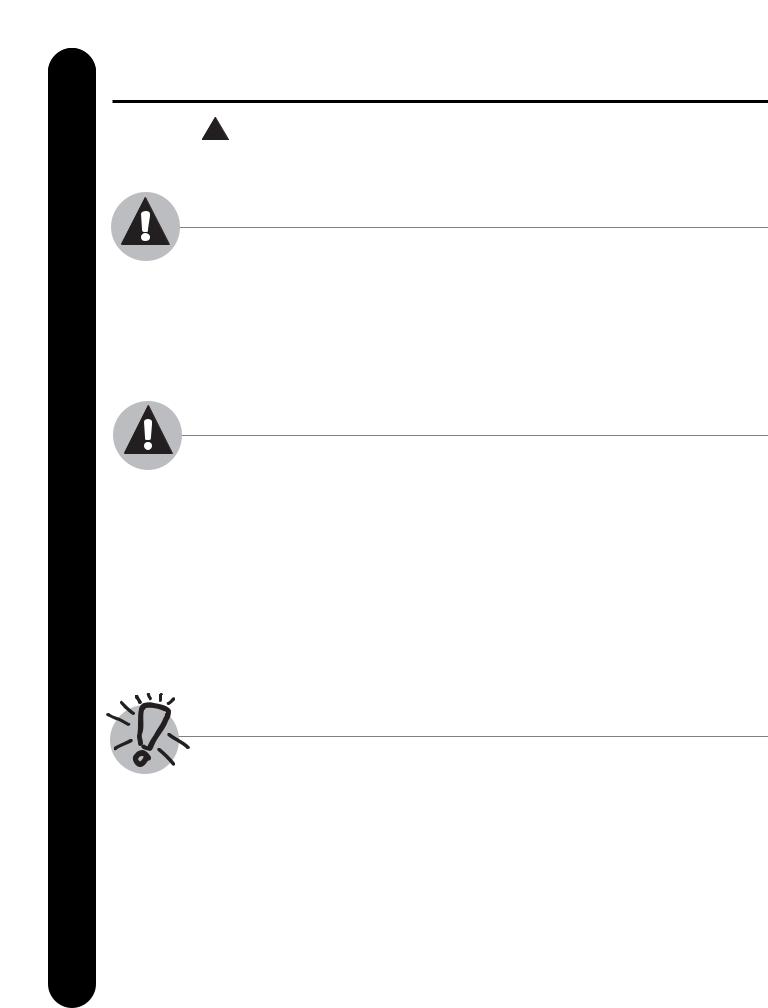
Customer Service Troubleshooting Tips Care and Cleaning Operating Instructions Installation Instructions Safety Instructions
IMPORTANT SAFETY INFORMATION. READ ALL INSTRUCTIONS BEFORE USING.
! WARNING!
For your safety, the information in this manual must be followed to minimize the risk of fire or explosion, electric shock, or to prevent property damage, personal injury, or loss of life.
FOR INSTALLATIONS IN THE STATE OF CALIFORNIA
California Law requires that residential water heaters must be braced, anchored or strapped to resist falling or horizontal displacement due to earthquake motions. For residential water heaters up to 52-gallon capacity, a brochure with generic earthquake bracing instructions can be obtained from: Office of the State Architect, 400 P Street, Sacramento, CA 95814 or you may call 916-445-8100 or ask a water heater dealer.
However, applicable local codes shall govern installation. For residential water heaters
of a capacity greater than 52 gallons, consult the local building jurisdiction for acceptable bracing procedures.
SAFETY PRECAUTIONS
Have the installer show you the location of the gas shut-off valve and how to shut it off if necessary. Turn off the manual shut-off valve if the water heater has been subjected to overheating, fire, flood, physical damage or if the gas supply fails to shut off.
●Read this manual entirely before installing or operating the water heater.
●Use this appliance only for its intended purpose as described in this Use and Care Manual.
●Be sure your appliance is properly installed in accordance with local codes and the provided installation instructions.
●Do not attempt to repair or replace any part of your water heater unless it is specifically recommended in this manual. All other servicing should be referred to a qualified technician.
READ AND FOLLOW THIS SAFETY INFORMATION  CAREFULLY.
CAREFULLY.
SAVE THESE INSTRUCTIONS
6
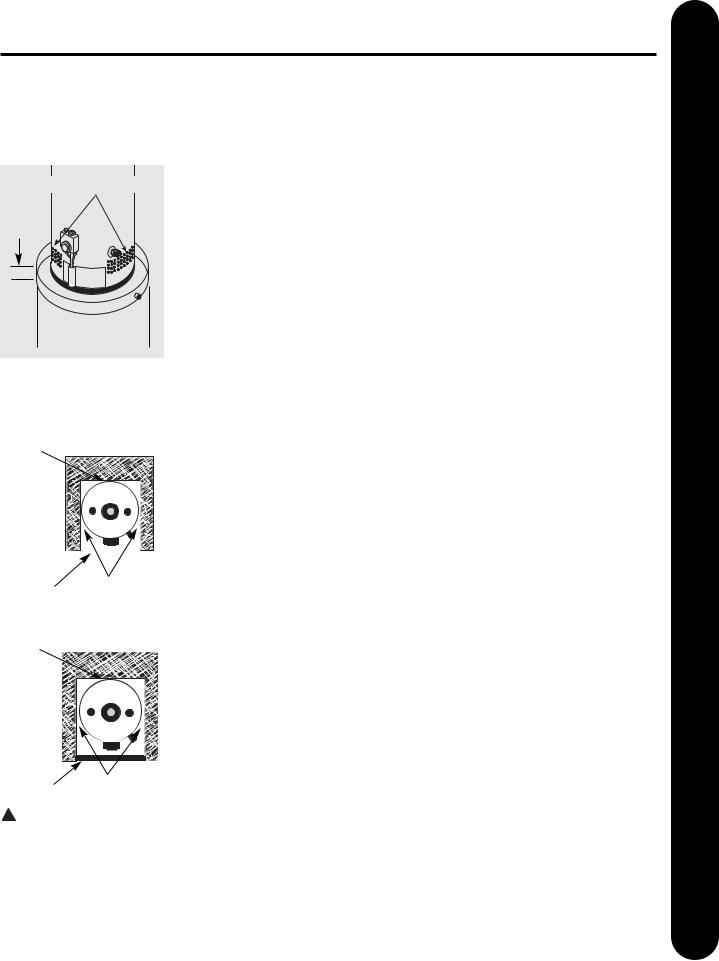
Installing the water heater.
This water heater must be installed in accordance with these instructions, local codes, utility company requirements, and/or in the absence of local codes, use the latest edition of the American National Standard/National Fuel Gas Code. A copy can be purchased from either the American Gas Association, 400 N. Capitol Street NW, Washington, DC 20001 as ANSI standard Z223.1 or National Fire Protection Association, 1 Batterymarch Park, Quincy, MA 02269 as booklet NFPA 54.
Combustion Air Inlet
Combustion Air Inlet Openings
Openings
Max.
2”
Diameter of  water heater
water heater  plus 2” min.
plus 2” min.
The auxiliary catch pan installation MUST conform to local codes.
Top View Alcove
Rear
Sides
Front Open
Top View Closet
Rear
Sides
Front Enclosed
! WARNING: Combustible construction refers to adjacent walls and ceilings and should not be confused with combustible or flammable products and materials. Combustible and/or flammable products and materials should never be stored in the vicinity of this or any gas appliance.
Location
The water heater should not be located in an area where leakage from the tank or connections will result in damage to the area adjacent to the heater or to lower floors of the structure.
When such areas cannot be avoided it is recommended that a suitable catch pan, adequately drained, must be installed under the water heater.
The pan must not restrict air flow to the combustion air inlet openings (perforation openings) located around the lower perimeter of the water heater.
Catch pan kits are available from the store where the water heater was purchased, or any water heater distributor.
Make certain the floor underneath the water heater is strong enough to sufficiently support the weight of the water heater once it is filled with water.
A gas fired water heater or any other appliance should not be installed
in a space where liquids which give off flammable vapors are to be used or stored. Such liquids include gasoline, LP gas (butane or propane), paint or adhesives and their thinners, solvents or removers.
When installed in a closet, DO NOT block or obstruct any of the combustion air inlet openings located around the perimeter of the water heater. A minimum of 1” is required between these combustion air inlet openings and any obstruction.
Because of natural air movement in a room or other enclosed space, flammable vapors can be carried some distance from where liquids which give off flammable vapors are to be used or stored. The open flame of the water heater’s pilot or main burner can ignite these vapors and create a shut down condition of the water heater which will not allow the water heater to ignite until examined by a Qualified Service Technician.
The water heater must be located so it is not subject to physical damage, for example, by moving vehicles, area flooding, etc.
If local codes require the use of a stand kit to raise the water heater 18” above the floor, please contact the store where the water heater was purchased, or any water heater distributor. These kits must comply with local codes.
●The water heater should be installed as close as practical to the gas vent or chimney.
●Long hot water lines should be insulated to conserve water and energy.
●The water heater and water lines should be protected from exposure to freezing temperatures.
●Do not install the water heater in bathrooms, bedrooms, any occupied rooms normally kept closed, or in unprotected outdoor areas.
●Minimum clearance from combustible construction:
Location |
Front |
Sides |
Rear |
Top |
|
|
|
|
|
|
|
Alcove |
3” |
0” |
0” |
12” |
|
(7.6 cm) |
(0 cm) |
(0 cm) |
(30.5 cm) |
||
|
|||||
|
|
|
|
|
|
Closet |
3” |
1” |
0” |
12” |
|
(7.6 cm) |
(2.5 cm) |
(0 cm) |
(30.5 cm) |
||
|
|||||
|
|
|
|
|
If the clearances stated on the Instruction/Warning Label, located on the front of the heater differ, install the water heater according to the clearances stated on the label.
●If the water heater is installed in an alcove or closet, the entire floor must be covered by a wood or metal panel. A minimum of 24” clearance from the front and top should be available for adequate inspection and servicing.
●The water heater may be installed on combustible floors, but not directly on carpeting. If the water heater must be installed on carpeting, place a metal or wood panel beneath the water heater, extending beyond its full width and
depth at least 3” in all directions. |
7 |
Service Customer Tips Troubleshooting Cleaning and Care Instructions Operating Instructions Installation Instructions Safety
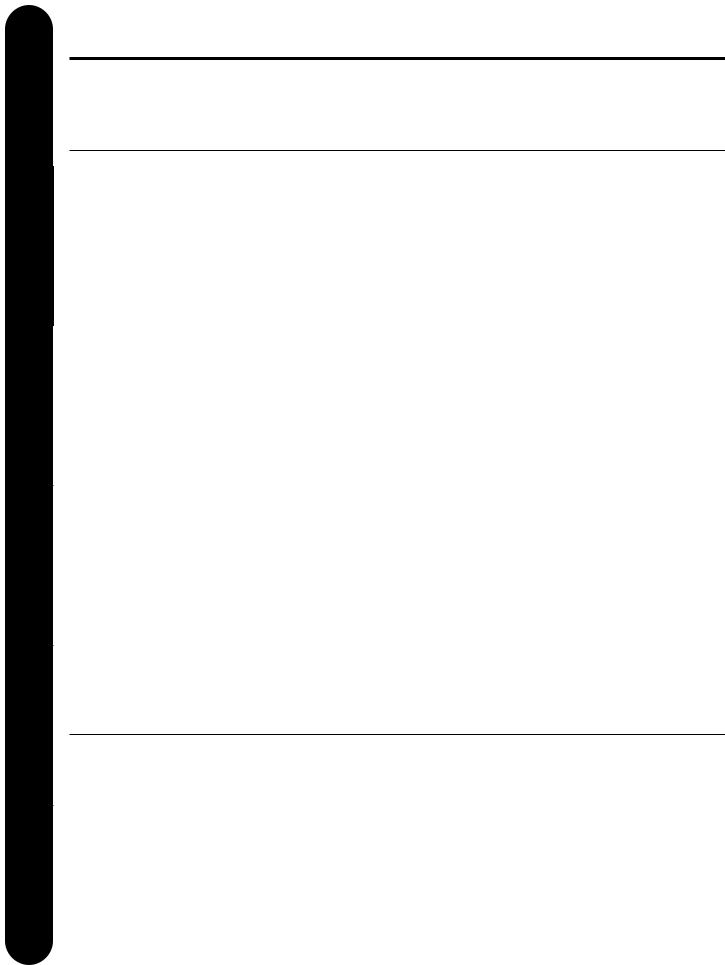
Customer Service Troubleshooting Tips Care and Cleaning Operating Instructions Installation Instructions Safety Instructions
Inspect Shipment
Inspect the water heater for possible damage. Check the markings on the rating plate of the water heater to be certain the type of gas supplied corresponds to the water heater requirements.
Combustion and Ventilation Air
Proper operation of the water heater requires air for combustion and ventilation. Provisions for combustion and ventilation air must comply with referenced codes and standards.
When installed in a closet, DO NOT block or obstruct any of the combustion air inlet openings located around the perimeter of the water heater. A minimum of 1” is required between these combustion air inlet openings and any obstruction.
NOTICE: If the water heater is installed in an unconfined space within a building of conventional frame, masonry or metal construction, infiltration air is normally adequate for proper combustion and ventilation. If the water heater is installed in a confined space, provisions for combustion and ventilation air must be made.
A confined space is one having a volume of less than 50 cubic feet per 1000 Btuh of the aggregate input of all appliances within that space.
The air must be supplied through two permanent openings of equal area. One is to be located within 12” above
the floor and the other is to be located within 12” from the ceiling.
The minimum net free area of each opening must not be less than one square inch per 1000 Btuh of the total input rating of all
the appliances in the enclosure (but not less than 100 square inches), if each opening communicates with other unconfined areas inside the building.
Buildings of unusually tight construction shall have the combustion and ventilation air supplied from outdoors, or a freely ventilated attic or crawl space.
If air is supplied from outdoors, directly or through vertical ducts, there must be two openings located as specified above and each must have a minimum net free area of not less than one square inch per 4000 Btuh of the total input rating of all the appliances in the enclosure.
If horizontal ducts are used to communicate with the outdoors, each opening must have a minimum net free area of not less than one square inch per 2000 Btuh of the total input rating of all the appliances in the enclosure. If ducts are used, the minimum dimensions of rectangular air ducts shall not be
less than 3”.
NOTICE: If the duct openings which supply combustion and ventilation air are to be covered with a protective screen or grill, the net free area (openings in the material) of the covering material must be used in determining the size of the openings. Protective screening for the openings MUST NOT be smaller then 1/4” mesh to prevent clogging by lint or other debris.
NOTICE: The water heater should not be installed near an air supply containing halogenated hydrocarbons.
Corrosive Atmospheres
The air in beauty shops, dry cleaning establishments, photo processing labs, and storage areas for liquid and powdered bleaches or swimming pool chemicals often contain such halogenated hydrocarbons.
An air supply containing halogenated hydrocarbons may be safe to breathe, but when it passes through a gas flame corrosive elements are released that will shorten the life of any gas burning appliance.
Propellants from common spray cans or gas leaks from A/C and refrigeration equipment are highly corrosive after passing through a flame.
The water heater warranty is voided when failure of the heater is due to operation in a corrosive atmosphere.
8
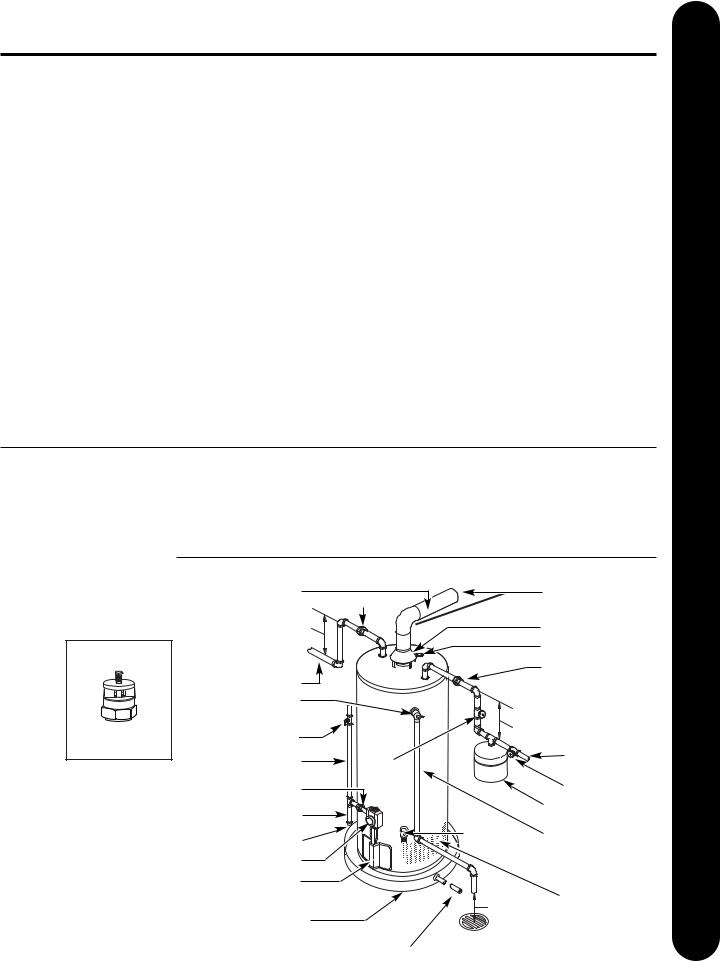
Thermal Expansion
Determine if a check valve exists in the inlet water line. Check with your local water utility. It may have been installed in the cold water line as a separate back flow preventer, or it may be part of a pressure reducing valve, water meter or water softener. A check valve located in the cold water inlet line can cause what is referred to as a “closed water system”. A cold water inlet line with no check valve or back flow prevention device is referred to as an “open” water system.
As water is heated, it expands in volume and creates an increase in the pressure within the water system. This action is referred to as “thermal expansion”. In an “open” water system, expanding water which exceeds the capacity of the water heater flows back into the city main where the pressure is easily dissipated.
A “closed water system”, however, prevents the expanding water from flowing back into the main supply line, and the result of “thermal expansion” can create a rapid and dangerous pressure increase in the water heater and system piping. This rapid pressure increase can quickly reach the safety setting of the relief valve, causing it to operate during each heating cycle. Thermal expansion, and the resulting rapid, and repeated expansion and contraction of components in the water heater and piping system can cause premature failure of the relief valve, and possibly the heater itself. Replacing the relief valve will not correct the problem!
The suggested method of controlling thermal expansion is to install an expansion tank in the cold water line between the water heater and the check valve (see illustration below). The expansion tank is designed with an air cushion built in that compresses as the system pressure increases, thereby relieving the over pressure condition and eliminating the repeated operation of the relief valve. Other methods of controlling thermal expansion are also available. Contact your installing contractor, water supplier or plumbing inspector for additional information regarding this subject.
IMPORTANT: Do not apply heat to the HOT or COLD water connections. If sweat connections are used, sweat tubing to adapter before fitting adapter to the cold water connections on heater. Any heat applied to the cold water supply fittings will permanently damage the dip tube.
Water Supply Connections
Refer to the illustration below for suggested typical installation. The installation of unions or flexible copper connectors is recommended on the hot and cold water connections so that the water heater may be easily disconnected for servicing if necessary. The HOT and COLD water connections are clearly marked and are 3/4” NPT on all models. Install a shut-off valve in the cold water line near the water heater.
Typical Installation
Vent connector |
Union |
Pitch up 1/4” |
|
to chimney |
per foot |
||
|
Vacuum Relief Valve
(Not Supplied)
If required, install per local codes and valve manufacturer’s instructions.
NOTICE: The National Fuel Gas Code (NFGC) mandates a manual gas shut-off valve: See (NFGC) for complete instructions. Local codes or plumbing authority requirements may vary from the instructions or diagrams provided and take precedent over these instructions.
Heat trap |
|
Draft hood |
|
6” minimum |
|
Anode |
|
|
|
||
|
HOT |
|
|
Hot water outlet |
|
Union |
|
to fixtures |
COLD |
|
|
|
|
||
Temperature and |
|
|
|
pressure relief valve |
Heat trap |
||
Manual gas shut-off |
6” minimum |
||
Shut- |
To cold water |
||
|
|||
|
off |
||
To gas supply |
supply |
||
valve |
|||
|
|
||
Ground joint union |
|
Shut-off valve |
|
Sediment trap |
|
Thermal expansion |
|
|
tank (if required) |
||
|
Drain valve |
||
Cap |
Relief valve |
||
|
|||
Thermostatic gas valve |
|
discharge line to |
|
|
suitable open drain. |
||
Jacket door |
|
Combustion Air |
|
|
6” air gap |
||
|
Inlet Openings |
||
Auxiliary catch pan |
|
|
|
|
Drain Pan Pipe to |
|
|
|
suitable drain |
|
|
Service Customer Tips Troubleshooting Cleaning and Care Instructions Operating Instructions Installation Instructions Safety
